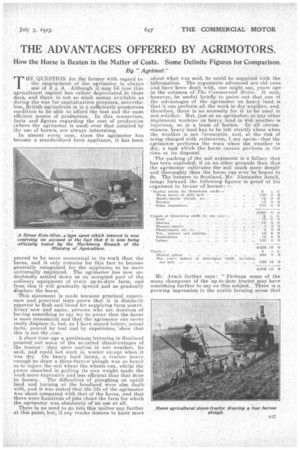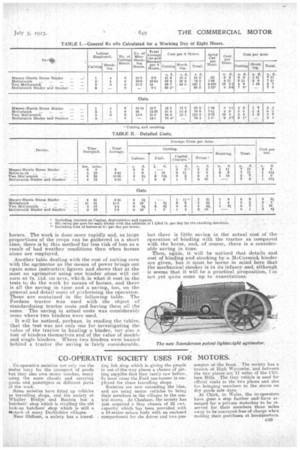THE ADVANTAGES OFFERED BY AGRIMOTORS.
Page 37

Page 38

Page 39

If you've noticed an error in this article please click here to report it so we can fix it.
How the Horse is Beaten in the Matter of Costs. Some Definite Figures for Comparison, By " Agrimot."
T• HE QUESTION, for. the farmer with regard to . the employment -DI -trtie agrimOtor is always en,e of X . s.. 0, : Although it may We true that agricultural capifal has rather clipreciated in these days, and there . is not so. Much money, available as during the war for capitalization purposes, nevertheless, British agriculture is in a sufficiently prosperous condition to be able to afford the hest and the most efficient means of production. In this connection, facts and Agures regarding the cost of production (where the agrimotor is used) over that entailed by the' use of horses, are always interesting.
In almost' every ease, since the agrimotor has become a standardized farm appliance, it has been proved to be more economical in its lvork than the horse, and it only remains for this fact to become generally recognized for the appliance to be more universally employed. The agrimotor has now undoubtedly settled down as an accepted part of the ordinary equipment of every up-to-date farm, and from this it will gradually spread and as gradually displace the horse.
This statement Is made because practical experience and practical tests prove that it is distineily superior to flesh and blood for supplying farm power. Everynow and again, persons who are desirouS of having something to say try to prove. that the horse is more econornica-1 and that the agrimotor can never really displace it, but, as I have stated before, actual facts, proved by test and by experience,-show that this is not the. ease.
A short time ago a gentleman lecturing in Scotland pointecVout sonie of the so-called disadvantages of the tractor : they were useless in wet weather, he said, and could not, work in winter except when it Was dry. On heavy land farms, a tractor heavy, enough i0 draw a three-lurrow-plough• was so heavy as to injure the soil where the wheels run, whiht the cower absorbed in pulling its own weight made the work-mare expensive and leSs efficient than that done by horses: The difficulties of ploughing on uphill land and turning at the headland were also dealt with, and it was stated that the life of the agrirnotor was short compared With that of Ole lri.se, and that -there were hundreds of Jobs about the farm.for•which the agrimotor was, absolutely, of no.use.at all:
There is no need to gointo this matter any farther at this point, but, if any reader desires to know more ...about what was said, he could he supplied with the information. The _arguments advanced are old ones and have"been dealt with, one might say, years ago
. the columns of The Commercial Motor. It may, however, be useful briefly tit point out that one of the advantages of the agrimator Oil heavy land is -that it-cati perform all the work in dry weather, .and, • therefore, there is no necessity for it to be used in wet Wather: But, just as an agrimotOr, or.any Other implement workinff on heavy land in wet weather is injurious, so. is a team of horses. In all (dram-. stances, heavy land has to be left strictly alone when the weather is not ..favoura.ble, and, at the risk of being charged with reiteration, I say again--that the agrimotur performs the work when the weather is dry, a task which the horse cannot perform :in the time at its disposal.
The packing of the soil argument is a fallacy that has been exploded, if on no other grounds than that the agrimotor cultivates the 'Soil much more deeply and thoroughly than the horse can ever be hoped to do. The lecturer iii Scotland, Mr. Alexander Artnit, hrings _forward the following figures in proof of his t.rgurnent in favour of horses
Mr. _Arndt further says : " Perhaps some of the many champions of the up-to-date tractor may have something further to say -on this subiect. There is a growing impression in the arable farming areas that the tractor has come to stay. What have the tractor champions to say on the subject Needless to say, the tractOr champions were not long in bringing forward arguments to show that Mr. Armit was not very correct in his statements, and in the British Farmer of May 26th the following tables were quoted against those of Mr. Armit
" Comparing these figures with Mr. Armit's estimate of horse costs, we 6nd that the tractor outfit costs only .215 more than a three-horse team and equipment. Moreover, this slight balance in initial outlay is worked out five times over during the first year of operation by a reduction in running costs of
178 10s. 8d. .
" But, surely, the important point is the amount of work. done during the year ! To make our comparisob clear, it is more simple to consider the work of all the various operations on the farm as the equiva. lent of ploughing. The three-horse outfit could not be expected to do more work than the eqiiivalent of 200 acres of rrloughing,i-n the, year ; the
.cost ttaking
Mr. .Armit's figures and neglecting interest on initial capital) would therefore be £228 18s. divided by 200, i.e., .21 2s. 11d. per ,acre. A Fordson tractor can easily plough an average of three--four acres daily, ant! in it working days (say, 80) we can safely say that work equivalent to 300 acresof plOughing would .be done. Thus (again neglecting interest on initial capital) the cost of ploughing by Fordson works out at £150 7s 4d. divided by 300, i.e„ approx. 10s, per acre.
`,This striking comparison indicates clearly the fact that the tractor has not only come to stay,' but that•the next few years will see a far wider use of mechanical power in agriculture." , • These figures are quoted because they voice, on the one hand, the opinion of a man who claims to be practical, and, on the other, the opinion of a man
ha is both experienced and scientific. The Commercial 'llotor has its own facts. and figures en
the subject, which have been quoted more than once, but it is as well to get outside in these matters so far as ptissible and to obtain opinions and particulars of the results of investigations so that there may be no fear of partiality. lin this connection, the figures given by the •Machinery branch of the Ministry of Agriculture are both interesting_ and useful. It may not be generally known that the Ministry of Agriculture has set up an Advisory Committee which has -already sat, and whose recommendations are to be' carried into sheet by the Ministry. It is decided that public trials and demonstrations are not to be encouraged, at least by the Ministry. These are to be left to the trade, but already some useful work, to which the following tables refer, has been accent-. plished. Below is a table which gives the results of a test of mowing in which tractors and tractor attachments are coinpared with the work of horses, and it will be seen•that some of the tractor outfits compare very favourably indeed in the matter of costs. The Fordson tractor with two Bentall mowing inaehines and a Cutmore attachment will do the work at a little more than half the cost of two horses.
Generally, 'grass mowing and corn cutting are well done by the mower and the reaper respectively drawn by horses, but at this work horses soon get tired and, if the work is to be carried on continuously, there must be a regular change of horses, whereas the great advantage of the agrimotor is that it can, and does, work continuously over long periods without a stop except that required by the driver. The general conclusion is that it. is considerably cheaper to draw two mowers by agrimotors or to use a mowing attachment, than to do the work by horse labOur alone, or with one machine behind the agrimotor. With regard to hauling, it has been pointed out in these columns many times, and it is generally recognized, that hauling by tractor is more economical and consequently much more profitable than by
horses.. The work is done more rapidly and, as large proportions of the crops can be gathered in a short time, there is by this method' far less risk of loss as a result of bad weather conditions than when horses alone are employed.
Another table dealing with the cost of .cutting corn with the agrimoter•as the means of power brings out again some instructive -figures and shows that at the most an agrimetor using one binder alone will Cut corn at 7s. 11d.• itn acre, :whi•AL is what it cost in the _ tests to do the work by means of horses, and there. is all the saving in time and a saving, too, on the general and detail costs of pc:Joni-ling the operation. These are contained in the following table, The Fardson . tractor was used with the object of standardizing tractor costsand having them all the same. • The saving in actual costs was considerably more where two binders were used. • It will be noticed, perhaps; in reading the tables, that the test was not only one for investigating the Naltie of the tractor in hauling a binder, but also a test of binders themselves and of the value Of double and single binders. 'Where two binders were hauled behind a tractor the saving is fairly considerable,
but there is little saving in the actual cost of the operation of binding with the tractor as compared. with the horse, and, of course, there is a considerable saving in time.
Then' again,. it will be noticed that details andcost of binding and stooking by-a. -McCormick binder are given, but it must be borne in mind here that the mechanical stOoker is in its infancy and, although it seems •that it will he a practical proposition, I. as not yet quite come up to expectations.














































